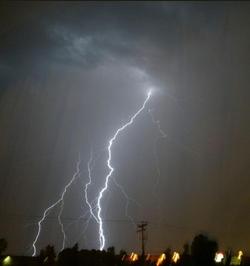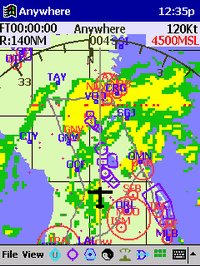When a Product Saves a Life, It's Worth a Plug
 LifeLine is a volunteer organization
manned by 1,500 pilots who donate their time and aircraft to
transporting 10,000 critically ill patients a year on a moment's
notice. They have flown over 30,000 missions since they were
founded in 1978. They are merging with another
organization, Angel Flight, this month. These organizations are
responsible for saving thousands of lives through the quick and
generous actions of member pilots across America.
LifeLine is a volunteer organization
manned by 1,500 pilots who donate their time and aircraft to
transporting 10,000 critically ill patients a year on a moment's
notice. They have flown over 30,000 missions since they were
founded in 1978. They are merging with another
organization, Angel Flight, this month. These organizations are
responsible for saving thousands of lives through the quick and
generous actions of member pilots across America.
Mike Harbater was sitting at his desk in the Bronx
going through a warehouse inventory list for his construction
business. He was a little tired of flying having spent a large part
of Sunday on an AirLifeLine mission transporting three children and
their chaperone from actor Paul Newman's "Hole In The Woods" camp
for children with cancer in upstate New York. They flew to JFK for
their flight home to Switzerland. He was, as he describes it,
"flown out."
A call came in from Sacramento, California. The LifeLine
dispatcher sounded urgent so he put down the list. A liver had been
located for a transplant patient who had to be flown to Pittsburg,
Pennsylvania for surgery. The window was six hours. Mike was an
hour by car from Republic Airport on Long Island where his Cessna
Centurion was hangared.
 Five hours. A quick glance at
weather radar on the Internet showed constellations of storm cells,
some organized into large systems, all over the northeast. Heavy
rain and storms stretched from the DelMar, Virginia Peninsula to
Northern New Jersey and were moving slowly northward. The only
chance he had was to get north of the weather before it blocked his
path westward. He advised the flight coordinator that there was a
pretty good chance that he couldn't safely make the flight but that
considering the emergency nature of the patient, he would certainly
try.
Five hours. A quick glance at
weather radar on the Internet showed constellations of storm cells,
some organized into large systems, all over the northeast. Heavy
rain and storms stretched from the DelMar, Virginia Peninsula to
Northern New Jersey and were moving slowly northward. The only
chance he had was to get north of the weather before it blocked his
path westward. He advised the flight coordinator that there was a
pretty good chance that he couldn't safely make the flight but that
considering the emergency nature of the patient, he would certainly
try.
After accepting the flight assignment, called his wife at their
home in Far Rockaway, and then called ahead to the airport to have
the plane fueled and ready. The patient would be waiting at the
airport.
The weather was miserable. A stationary trough aloft
was pumping gobs of moist, unstable Gulf air up the Atlantic
Seaboard from deep in Dixie to the far reaches of New England.
Daily towering cumulonimbus and embedded thunderstorms had been the
rule for a week and there were no signs of change. Flying
through the busy North East corridor even in VFR conditions is a
demanding task, and many regional airports were now below minimums.
The clock was ticking.
 He drove as fast as traffic would
allow through the Bronx to the Throggs Neck Bridge glancing
nervously at the leaden gray sky above; a hand-held radio tuned to
a local weather frequency reported deteriorating conditions. An
hour later he pulled into Republic Airport and up to the terminal
where a small group of people were standing outside waving him
over.
He drove as fast as traffic would
allow through the Bronx to the Throggs Neck Bridge glancing
nervously at the leaden gray sky above; a hand-held radio tuned to
a local weather frequency reported deteriorating conditions. An
hour later he pulled into Republic Airport and up to the terminal
where a small group of people were standing outside waving him
over.
Patient Frank D. who was staying on Long Island, had gotten "The
Call" from the transplant coordinator in Pittsburgh, PA. A
potential transplantable liver was available and he was finally
first on the list. Frank had contracted Hepatitis C while serving a
tour of Army duty in Vietnam in 1969. Over the years the disease
had slowly destroyed his liver and the now, cirrhotic organ had to
be replaced if he was to survive.
Harbater got out of his car and strode quickly into the building
heading straight for the terminal to get radar images of the region
and reevaluate the flight for Go/No Go. The terminal screen was
black, the network was down. Mike owned a portable weather radar
system for his aircraft, Anywhere WX, from Control Vision. Out at
the plane, he started up, pressed the weather button and 45 seconds
later got a current radar picture. The flight was a Go: the mission
was ON.
The Centurion took off at 12:28 PM after 24 minutes waiting for
a clearance, filed for IFR routing to get around the minefield of
storm systems. The route Air Traffic offered didn't look right
against the recent radar returns on his Anywhere WX. He requested,
and ultimately got cleared to Elmira NY, just south of the Finger
Lakes. Multiple requests for NEXRAD through the AnywhereWX system
offered definitive, near real-time images that allowed him to pick
his way through the cells and towering storm clouds that were
hidden in the murk. As they approached Elmira and made their way
north around the last active cell, Mike told his passenger that as
soon as they cleared this last red blotch on the screen they'd be
making a hard left, direct to Pittsburgh; there was no more weather
between them and their destination. This was corroborated by
Cleveland Center under whose control they were at that time.
Harbater also told him that without the AnywhereWX system, they'd
still be in New York and this opportunity for survival would have
been lost
 For the next three hours, Harbater
flew around storm cells with Anywhere WX at 11,000 feet. He
couldn't fly any higher; his passenger wasn't in any condition to
put on an oxygen mask. The route became a zigzag around
thunderstorms and heavy rain cells: scud running for a good
cause.
For the next three hours, Harbater
flew around storm cells with Anywhere WX at 11,000 feet. He
couldn't fly any higher; his passenger wasn't in any condition to
put on an oxygen mask. The route became a zigzag around
thunderstorms and heavy rain cells: scud running for a good
cause.
At 2:58 PM local time, the Centurion touched down at Allegheny
Airport in Pittsburg. Taxiing in he could see the flashing lights
of the waiting ambulance. He came to a stop, shut down the engine
and helped his passenger out. At 3:05 PM with 55 minutes left in
his transplant "window," Frank was on his way to the University
medical center where a waiting transplant team prepped him for
surgery. Seven hours later he was stable and recovering with a new
liver-and a new life.
"The [Anywhere WX] weather system didn't just help, it saved
this guy's life," said a very serious Mike Harbater. "I would never
have made it through without it."
 Classic Aero-TV: In Praise of Alabamas Patriot Aircraft USA
Classic Aero-TV: In Praise of Alabamas Patriot Aircraft USA NTSB Final Report: Cirrus Design Corp SR22
NTSB Final Report: Cirrus Design Corp SR22 ANN's Daily Aero-Term (12.21.25): Dead Reckoning
ANN's Daily Aero-Term (12.21.25): Dead Reckoning ANN's Daily Aero-Linx (12.21.25)
ANN's Daily Aero-Linx (12.21.25) Aero-News: Quote of the Day (12.21.25)
Aero-News: Quote of the Day (12.21.25)
 LifeLine is a volunteer organization
manned by 1,500 pilots who donate their time and aircraft to
transporting 10,000 critically ill patients a year on a moment's
notice. They have flown over 30,000 missions since they were
founded in 1978.
LifeLine is a volunteer organization
manned by 1,500 pilots who donate their time and aircraft to
transporting 10,000 critically ill patients a year on a moment's
notice. They have flown over 30,000 missions since they were
founded in 1978. 




